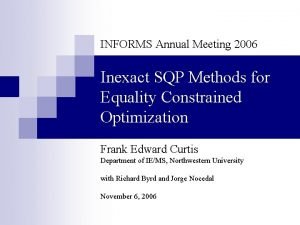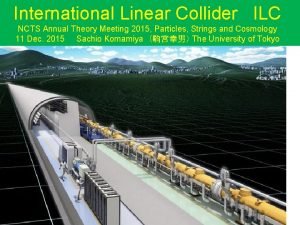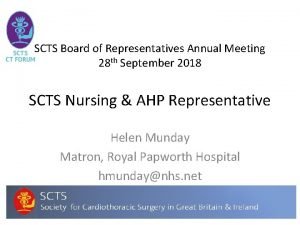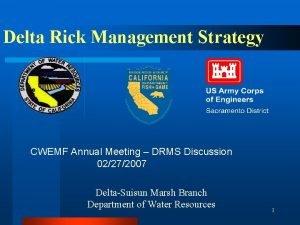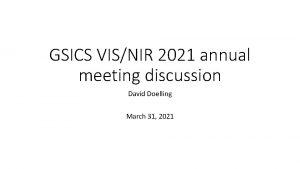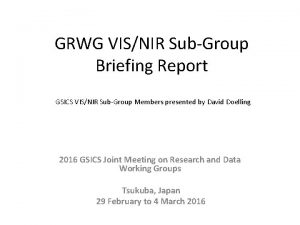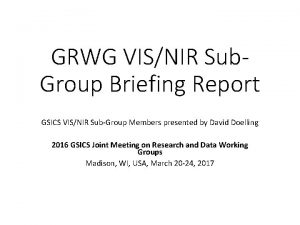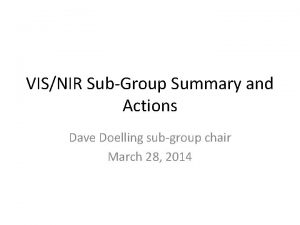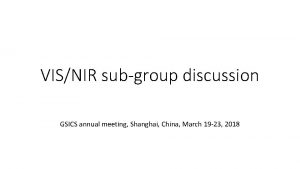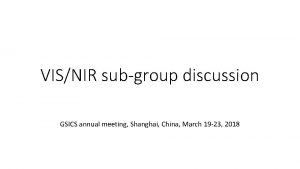VISNIR report Doelling Wagner 2015 GSICS annual meeting








- Slides: 8

VIS/NIR report Doelling, Wagner 2015 GSICS annual meeting, New Delhi March 20, 2015

Lunar goals 2015 • Continue existing collaborations and support • Organisation of web meetings (potentially 2 are identified before next annual meeting): • GIRO and GLOD policy + infrastructure set-up • Moving towards inter-calibration • Following recommendations and actions on the Lunar Calibration Community members (in particular on the issues related to oversampling factor and dark current estimation) • Uncertainty analysis

Lunar Objectives –Objective 1: Have all participants to the lunar calibration agreeing with the GIRO and GLOD policy as it is a prerequisite to the set-up of an infra-structure to share GIRO (code + executable) + GLOD –Objective 2: Set-up of this infra-structure (support from GDWG) –Objective 3 a: Enhancement to the ROLO using Pleiades data + re-analysis at USGS. –Objective 4 a: Upon availability of published enhancement to the ROLO, implementation of these enhancements. –Objective 3 b: Moving towards inter-calibration following the proposal presented during the meeting. –Objective 5: Collect new observations for the GLOD –Objective 6: Organise a new Lunar Calibration Workshop in 2016

Ver. 1 DCC methodology attributes # # 30 -day Mode # Hu Model # SBAF (NASA web site with precise DCC input) * Histogram interval * Domain boundaries (lat, lon), GMT image times * Deseasonalization *Can be modified by GEO domain # unless proven more effective

2015 VIS web meetings • DCC Deseasonalization – CMA (Gaussian), EUMETSAT(daily), NOAA (sinusoidal) – Noted that deseasonalization did not alter the trend just lowered the uncertainty • DCC mode reflectance for the absolute calibration – – – Aqua-MODIS/GEO IR 205 K consistency Apply exact technique to the MODIS data Check using DCC ray-matching Limit the Aqua-MODIS mode reference between 2002 -2009 GEO domain MODIS data to be submitted in the GSICS wiki • DCC Uncertainty analysis for product • Combining methods – NOAA (recursive filter), EUMETSAT, CMA, CNES • Update frequency – Separate the discontinuity analysis with the stability

Action Items • MODIS, Wherli on the web site put on GSICS web site – Not the same as Thuillier solar constant 2003 (CEOS recommendation), – NASA to put their SBAF, Solar Constant links on the GSICS wiki • • INSAT-3 D spectral response function on the GSICS wiki KMA to provide the KMA DCC BRDF model Develop ATBD with EUMETSAT as proto-type with other GPRCs Visible Netcdf-3 single product file for all visible calibration – Net. CDF-3 for plotting capability – Plotting package using % difference from nominal for each individual method (DCC, lunar, combined) and uncertainty – Nominal calibration should exist in the file – Merge coefficients separate parameter then the single methods, DCC and lunar • NOAA to compare Sebastien’s, Fangfang’s, Lin’s deaseasonalisation method • NASA to provide MODIS data over the GEO domains to establish DCC reference mode reflectance (2002 -2009) • Recommendation: Lin and Sebastien to evaluate the mean, mode, or median, use mode for now

VIS/NIR (primary) goals 2015 • DCC to demo mode Ver. 1 – Aqua-MODIS C 6 scan angle corrections, and 11µm C 5 to C 6 conversion factors • Lunar to demo mode Ver. 1 during 2016 • Combining methods Ver. 1

VIS/NIR (secondary) goals 2016 • Migrate from Aqua-MODIS to NPP-VIIRS – Use Deserts, Polar ice, DCC, lunar, SNO, double differencing to transfer calibration • DCC to other GEO bands, Ver. 2 – For wavelengths < 1 µm, uncertainty ~ 0. 65µm; twice the uncertainty for SWIR bands – Discontinuity detection • Improved ROLO model (Ver. 2) implementation • Develop Lunar hyperspectral traceable calibration


